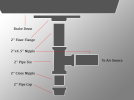My first forge, at age 11 in 1961, was an old hibachi (you youngsters will probably have to look that up) with a 90° piece of 4" duct under it and a 3-speed fan blowing into the duct. I burned coal from I picked up the sides of the coal train tracks. Luckily, it was met-coal (but I didn't know the difference back then). It got hot enough to ruin a lot of metal before I learned to close up the draft with a damper. Years later I built a Brake Drum Forge that was actually a pretty good forge. All the parts were scrounged except a bag of fire clay and some pipe fittings.
The biggest mistakes most folks make in building a home brew forge is too much air and no ash dump.
If all you will do is do HT, make a pit forge. It is a piece of 1.5" pipe with 1/4" holes drilled in it in the bottom of a dirt pit (if you have local clay soil, all the better). Use a small shop vac for the air supply, and a PVC valve to control the air blast. Use blocks of hardwood burned down to coals, hardwood charcoal, or blacksmith coal for the fire. Heck, for a simple HT, even chunks of 2X4s will work.
You will have to make some long handles tongs from a pair of HF needle-nose pliers. Do a Google, there are 100's of videos and tutorials on making them online. This simple forge and a strong welding magnet will do HT for most simple carbon steels. 1084 should be brought to non-magnetic and immediately quenched in warm canola or mineral oil.


